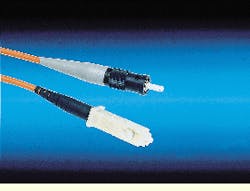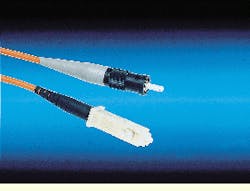Quick-connect fiber-optic connectors hasten fiber`s journey to the desk
Patrick McLaughlin
As growing numbers of end-users demand high-speed data networks, fiber-to-the-desk installations are becoming increasingly common. Fiber proponents have effectively spread the message that fiber-optic local area networks (lans) provide bandwidth far beyond what is needed by any of today`s applications, and that a fiber lan will effectively handle tomorrow`s applications as well.
Naturally, as fiber networks proliferate, the components of these networks mature through technological advancement. Quick-connect fiber-optic connectors are an example of this phenomenon. Introduced as time-saving alternatives that do not require the application or curing of epoxy, quick-connects were designed to cut down on overall fiber-installation cost by sharply reducing termination time. Even though end-users pay a slight premium for quick-connects over epoxy-type connectors, there is a savings in labor costs because of the rapid termination that quick-connects allow (see Product Update table on page 16).
Prepolishing vs. field polishing
Cavin Sambury, registered communications distribution designer (rcdd) and president of Computel Networks (Edmonton, AB, Canada), says not having to add epoxy to a connector is desirable for reasons other than time savings. "Putting the epoxy in is not bad," he says. "It`s a standard procedure. But the problem is having to polish that epoxy. We once did an installation with epoxy-type connectors in a cement factory. Even when we were in an office setting, there was still a lot of dust flying around. It was a real nightmare trying to keep the connectors clean."
Some quick-connect manufacturers have completely eliminated the need to polish in the field by loading the connector with a fiber and polishing that fiber in the factory. To terminate connectors with preloaded fiber stubs, installers must prepare and cleave the fiber, insert it into the connector, then crimp the connector. For this reason, they are commonly referred to as "cleave-and-crimp" connectors. Connectors without preloaded fiber stubs are terminated by preparing and inserting the fiber, crimping, then cleaving and polishing.
According to Richard Plamondon, manager of fiber-optic technology for nordx/cdt, polishing the fiber is the most critical step in terminating quick-connects, and prepolished connectors further speed termination time. "Polishing in the factory provides an advantage over any connector that requires polishing," he says. "Installation time is approximately one minute for experienced installers. And inexperienced installers do not have to learn how to polish."
Dan Silver, product development manager with 3M Telecom Systems Div., provides a different viewpoint. "In the past, with the three-step polishing process that included wet and dry polishing, it could take several minutes just to do the polishing in the field. But technology has come so far in areas like films and better-performing glass that even though now you might have to have a quick polish, it might not add a lot of time to the process. So you can polish a connector and still do a complete termination in two minutes."
Ceramic ferrules dominate
Ceramic ferrules, rather than metal or composite, are found in most quick-connects. Silver explains, "The ferrule is the most expensive part of the connector, so we examined other materials for use in cleave-and-crimp connectors. But we`ve found that ceramic ferrules provide the reliability and performance required in this type of connector."
Plamondon concurs. "We use only ceramic ferrules. It has always been the preferred material of the telecommunications industry because of its thermal properties and its resistance to wear, bending, and compression."
A characteristic that noticeably distinguishes quick-connects from one another is the tools required for termination. Proprietary tools are sometimes required to terminate quick-connect fiber-optic connectors, and this special tooling can affect overall cost-effectiveness. The labor-cost savings gained by using quick-connects can be offset, at least initially, by an investment in proprietary tools.
Jim Underwood, president of Northwest Fiberoptic Technologies Inc., which manufactures reusable connectors, agrees that proprietary tools can be a problem. He says the company kept that idea in mind when it was developing its newly released reusable ST-style quick-connect. "We said, `We don`t want another elaborate tool out there to confound the situation,` " Underwood says. "To terminate our product, you can use an array of tools that you`ll find in any installer`s tool kit--the strippers, the polishing plate, and puck--irrespective of the manufacturer of those tools."
3M`s Silver points out, "Most of the tools you need are generic, such as snips and strippers. You do, however, need to have a crimp tool with a die that compresses the crimp ring on the back of the connector to provide mechanical strength. So you have to have a crimp tool with the die in the tool. Almost everybody`s dimensions are going to be a bit different, so almost all of the crimp tools are proprietary to the individual connector."
Some manufacturers offer kits that include all the tools needed for terminating their quick-connects. Most tool kits include basic tools such as cable strippers, alcohol wipes, and scissors. But because the termination requirements for the various connectors differ, so do the contents of the tool kits. For example, tool kits for cleave-and-crimp connectors may include a different microscope than that used for connectors without preinstalled fiber stubs.
"Our tool kit includes a microscope," says nordx/cdt`s Plamondon. "However, it is not used for inspecting the ferrule because that`s already done in the factory. The microscope in our kit is used to inspect the cleave. It is slightly modified with a side port to insert the cleaved fiber." nordx/cdt also offers a refurbishing kit, which includes the consumables contained in the basic tool kit.
Tool kits of quick-connects that require polishing will most likely contain polishing film and a polishing puck.
Instructions for installing the connectors are also important. According to Plamondon, some installers` introductions to quick-connects were marked by frustration. "Despite the fact that quick-connects are easy to install, a lot of installers had initial failures," he says. "Many of them overlooked little details that are important. They were always told to be careful with epoxy connectors because they were delicate, but were not given appropriate guidance with quick-connects."
Instruction manuals, hands-on training, and hotline support are the most common training methods offered. Some manufacturers provide all three.
nordx/cdt`s Optimax ST-compatible and SC quick-connect fiber-optic connectors are polished in the factory to further reduce installation time.

